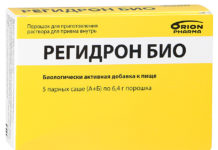The attractiveness of geranium, or pelargonium, in its openwork leaves. One has only to hurt them, as a strong aroma appears. Fragrant geranium is a beautiful attribute of a cozy house and a unique home healer.
Material Content:
Types and varieties of fragrant geranium
The birthplace of geraniums is South Africa. The leaves and stems of the plant are covered with thin glandular hairs that contain essential oil. When breaking off hairs, it enters the air and emits a characteristic odor.

Varieties of fragrant geraniums smell differently - roses, apples, lemons, oranges, pineapples, peaches, mint, lavender, verbena, wormwood, pine, coconut, almond, caramel.
There are natural types of pelargonium with fragrant leaves - fragrant, curly, pink, oak-leaved, capitate, felt, etc.
Varieties of fragrant pelargoniums of natural species:
- Chocolate Mint (felt). A bush up to 30 cm high with hanging shoots, green leaves with a chocolate stain in the center, smells like mint, small, pink flowers.
- Attar of Roses (capitate). About 45 cm tall, the leaves are large, three-lobed, smell of a rose, lilac flowers.
- Cy’s Sunburst (curly). Small corrugated foliage of light green color with a yellow border, smells like lemon, flowers are pink.
- Giant Oak. The leaves are large, lobed, emit a balsamic smell.
- Red-Flowered Rose (pink). The leaves are openwork, palmate, gray-green, blooms profusely with red-pink bright flowers.
Today, many hybrid varieties are also developed, which can differ from the natural species not only in flowers and leaves, but also in smell:
- Citronella Dark green, multi-leafed leaves with a strong citrus scent, pink flowers.
- Copthorne. The bush is about 50 cm high, the leaves are dark green with a cedar smell, the flowers are purple-pink with red spots.
- Grace Thomas. Thick bush up to 90 cm tall, leaves deeply dissected, smell like lemon and raspberries, flowers are pale pink with bright spots.
- Joy Lucille. Up to 60 cm tall, leaves with a menthol-mint aroma, pink-purple flowers.
- Lemon Kiss. A lush bush of about 40 cm, leaves are rough, jagged, with a pleasant lemon aroma, lilac-carmine flowers.
The intensity of the aroma depends on the growing conditions - air temperature, sunlight and the amount of moisture. It is advisable to select a variety whose aroma is most to their liking, and causes only positive emotions.
The chemical composition of the plant

The chemical composition of geranium is very rich, in the leaves and stems contain such substances:
- essential oils;
- organic acids;
- starch;
- Sahara;
- pectin;
- mineral salts;
- anthocyanins;
- vitamins;
- geranin, etc.
The plant contains no toxins, alkaloids, toxic substances, it can not cause poisoning.
Medicinal properties for the body
All types of plants have medicinal properties, but in medicine, fragrant geranium is most often used. It is her delicate, rugged leaves that go for the preparation of infusions and decoctions.
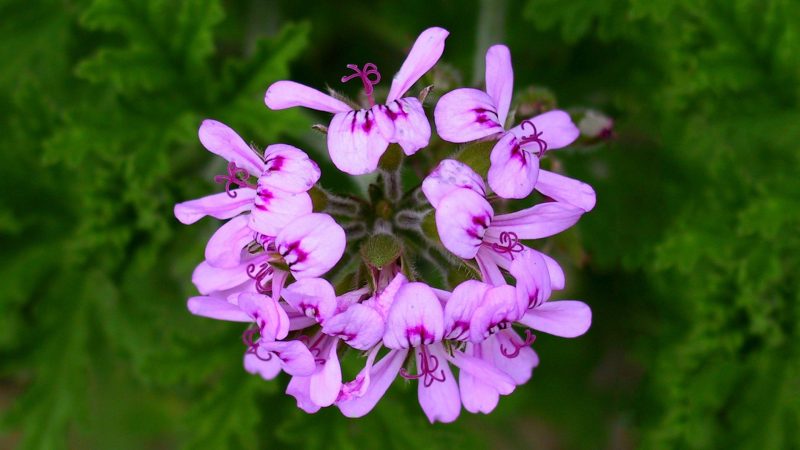
The healing properties of geraniums:
- bactericidal;
- anti-inflammatory;
- decongestant;
- astringent;
- painkiller;
- soothing and relaxing.
Geranium is used to treat neurological disorders and headaches associated with cramping.
Plant essential oil effectively destroys staph bacteria and other harmful microorganisms in the room air. The smell of geranium has a strong calming effect. Therefore, people who are suffering from neurosis or are in a stressful situation, it is recommended to put a flower in their bedroom in order to inhale the healing aroma during sleep.
Use in traditional medicine
The use of geranium in medicine is associated with its anti-inflammatory effect. Apply it, for example, with toothache. To do this, chew a sheet of geranium or put it on a bad tooth. Crumpled leaves are tied to children from the outside to the cheek; ingestion is not recommended. This method is used even in babies during teething.

Geranium juice is added to the water, gargle with ARVI and tonsillitis. It can also be instilled in the nose with a runny nose, sinusitis and sinusitis.
Read also:geranium pruning
Decoctions of leaves are treated:
- heart diseases;
- high blood pressure;
- gastritis;
- intestinal inflammation;
- urolithiasis.
Fresh and dried leaves of geranium are used as medicinal raw materials. Crumpled leaflets help soothe severe ear pain and relieve inflammation even with chronic otitis media.
Compresses with crushed leaves are used for radiculitis and osteochondrosis, they are applied to a sore spot, and the pain quickly passes.
Geranium juice heals wounds and burns on the skin. With high blood pressure, a crumpled sheet is applied to the wrist, after a while the pressure decreases.
Fragrant Geranium Medicines
For medical purposes, you can use not only fresh shoots of geranium, but also prepare them for future use.
Alcohol tincture
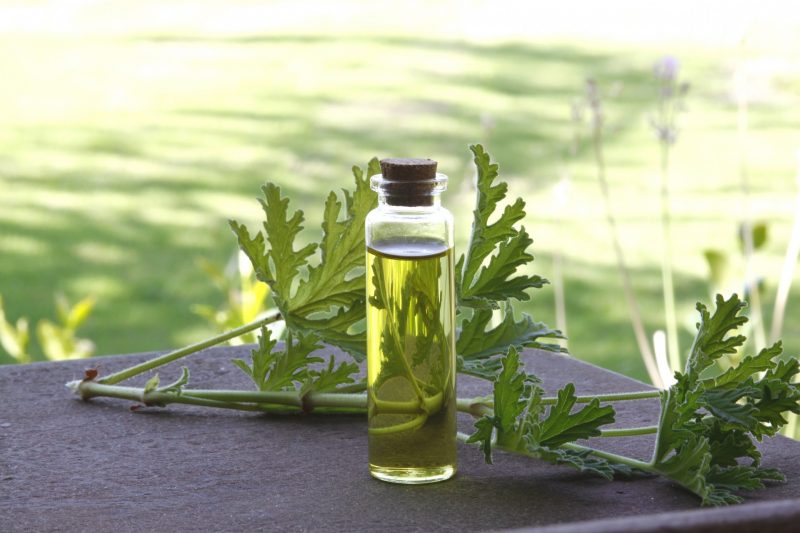
For the preparation of tincture 1 tbsp. crushed shoots are placed in a glass jar, pour 100 ml of pure 95% alcohol. Cover and set in a warm, dark place for 2 weeks. During this time, the extraction of beneficial substances will occur, they will move from the plant to the alcohol tincture. It can be used for medicinal purposes.
It is interesting:medicinal properties and contraindications of fir oil
Oil tincture
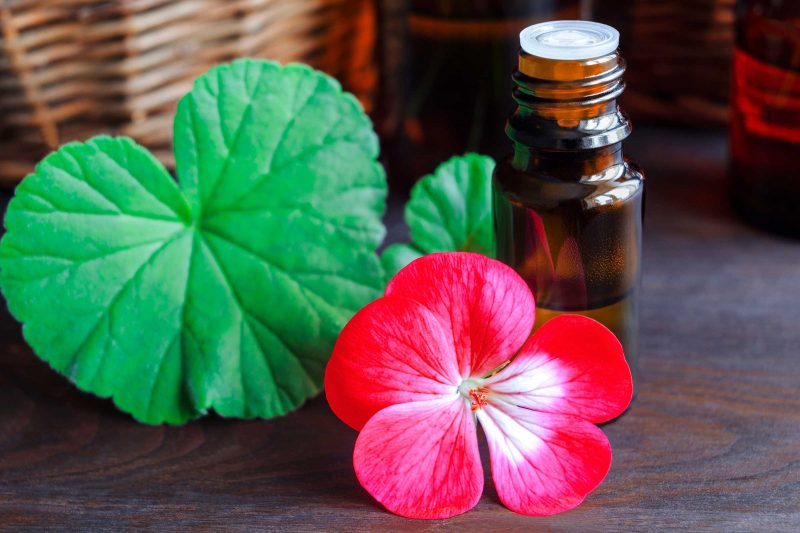
Based on alcohol tincture, you can prepare an oil, which will have a milder effect. To do this, add olive oil to a container with ready-made alcohol tincture of geranium leaves, put in a warm place for 2 weeks. After this period, the oil is drained, the vegetable residues are thrown out. Store the product in a tightly closed jar in a dark place. The drug is used in the same way as a fresh plant.
Geranium essential oil: benefits and harms
Fragrant Pelargonium essential oil is part of the elite French perfumes and cosmetics. In countries with tropical and subtropical climates, this plant is grown on an industrial scale. Oil is made from young leafy shoots. It consists of about 270 components, the most valuable of which are citronellol and geraniol.
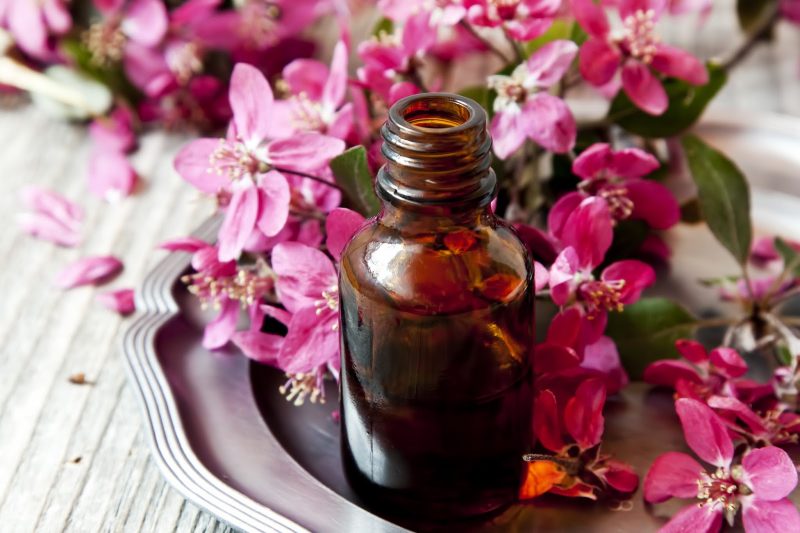
Geranium oil is used in the food industry to add flavor to confectionery and drinks.
In medicine, oil has been used since ancient times to treat infectious diseases, including pneumonia. It also stimulates the adrenal glands, has a tonic, calming, antispasmodic and wound healing effect.
Sometimes there is an individual intolerance to geranium oil and an allergy to it. In such cases, its use can be harmful.
Home care and growing
Pelargonium is a very unpretentious houseplant. It can be grown not only on the windowsill, but also on the veranda or in the garden. It’s good to take it out into the fresh air in the summer, and take it back to the apartment in the fall. The plant is drought tolerant, but with strong drying of the soil begins to lose leaves. It is also impossible to fill it - the roots immediately begin to rot.
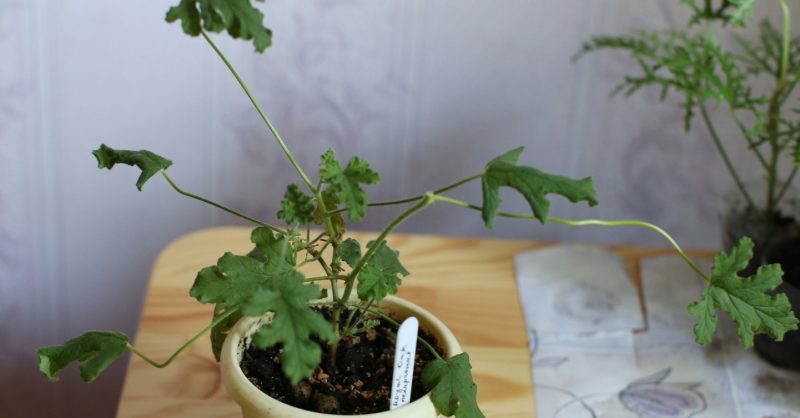
Pelargonium loves bright light. In partial shade, the essential oil ceases to be produced, and the aroma disappears.
The soil should be neutral or alkaline, light and fertile. You can use soil mixtures with a sufficient amount of peat and sand. Since February, pelargonium is being lightened and they begin to feed, they are forming a bush. Hybrid varieties propagated by cuttings.
Contraindications
Unlike medicinal preparations from other indoor plants, the use of geranium has almost no contraindications. The exception is childhood, when you can not drink geranium juice inside. In some people, plants with a strong odor cause allergies.
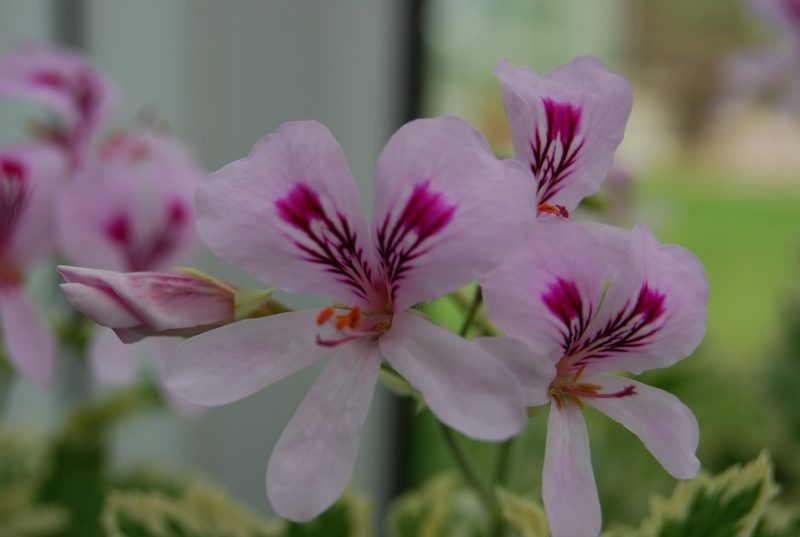
Home care for fragrant pelargonium is simple. In addition, she fills the house with enchanting scents, bringing peace, peace and creating a cozy atmosphere for life.







